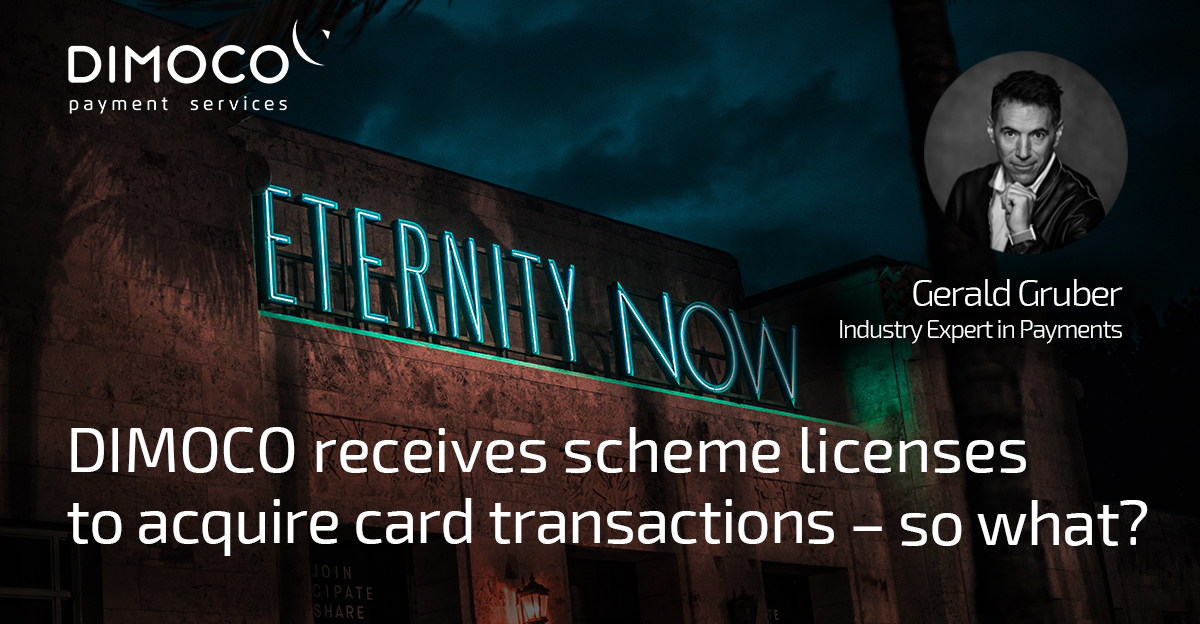DIMOCO Payment Services receives scheme licenses to acquire card transactions – so what?
There’s no shortage of so-called card acquirers for merchants, off- and on-line, one might think. More than 375 are active in Europe alone [1], and they come in many different flavors and sizes – some are traditional retail banks, some are more specialized payment institutions, and some are actually tech companies with the respective regulatory licenses. Some focus on the pure financial aspects of their service, some partner with tech service providers, and some offer integrated one-stop-shop solutions. So, what’s the big deal, if there’s one more?
Well, if you look at it as a piece of a larger puzzle, as a single step in a more comprehensive approach of DIMOCO to expand beyond their core business of direct carrier billing (DCB) into additional payment methods, aiming to be a one-stop-shop for merchants, there are several interesting aspects to it.
Choice vs. simplicity
The payments sector today is driven by technology and globalization. And while, in theory, one might envision a single global network connecting all merchants and consumers, enabling ubiquitous and efficient transactions between everyone, reality looks very different and much more fragmented for the foreseeable future.
Merchants want to sell to an increasingly global customer base, when, at the same time, many payment methods are still limited to certain geographies (e.g. iDeal in the NL, Swish in Sweden, ELV in Germany, etc.). As a consequence, merchants have to offer choice when it comes to payments, and ideally, this choice is provided by a single partner.
Consumers, on the other hand, lean heavily towards whatever makes a payment, an unpleasant activity by nature, as convenient and simple as possible [2], and in many cases that’s a method, they’re already used to, depending on where they live.
So, striking this balance between choice and simplicity is not only a challenge but actually a strategic prerequisite for success.
Defense vs. offense
DIMOCO’s move can also be viewed from a different angle. If you can offer your customers additional ways to receive payments, you can “lock them in”, prevent them from choosing other, alternative payment providers, who might start eating into your DCB business at some point. There’s an apparent defensive element to that.
On the other hand, with only around 11% of txns for digital content going through DCB [3] there’s plenty to win. Helping your customers sell through additional channels and winning new customers outside the existing DCB business seems a very smart offensive move.
And it makes sense: as a bigger fish in a smaller DCB pond, you may well want to defend whereas when you go out into the much bigger online payments pond, you’ll have to be aggressive to win some relevant share there. It will be interesting to see which part of the strategy dominates.
Big vs. small
There’s another reason, why DIMOCO’s development is worth watching. It’s the question of scale vs. agility. Today, the payment industry is heavily driven by scale. M&A activities worldwide are on record levels [4] and there’s a strong case for growth as long as it supports spreading the massive fixed costs of IT infrastructure across a larger number of transactions.
However, with ongoing consolidation complexity increases, integration efforts go up and there’s a certain risk that the ability to innovate and to react quickly to, for example, technological changes, might suffer.
Here, I’d argue, the focus for quite a while for DIMOCO will be on agility and speed to innovation, adding features like card acquiring to their platform and drive organic growth, before engaging in the acquisition game.
Last, but not least
DIMOCO’s decision to step into payment processing beyond direct carrier billing puts them in an arena with some real heavyweights of the industry, e.g. Wirecard, Klarna, or Stripe, and will get them some investor and media attention.
This not only good news for them but also for Austria as a hub for FinTech innovation, an aspect, which has long been neglected and underrepresented, but which has recently been gaining momentum and coverage with companies like Paysafe, Blue Code or BitPanda [5].
Overall, receiving a card payment acquiring license might seem a rather unspectacular thing, but if one looks a bit deeper, it might also be an indicator for the beginning of an exciting journey into new areas for DIMOCO.
[1] Payments Cards & Mobile
[2] provided that security is ensured, of course
[3] Telecoming, 2018
[4] 102 deals worth $46 Mio in the first 6 months of 2018 alone, more than double than the year before (Financial Times)
[5] and, of course, many others outside of payments

Gerald Gruber is an industry expert in technology, payments, and financial services. His work currently centers on digital transformation, payment strategy, and fintech / corp collaboration. He’s the founder of G2 Advisors, a niche-consultancy, served as the General Manager of Mastercard in Austria from 2012 to 2019, leading efforts to introduce various innovations from Debit Mastercard to GarminPay and ApplePay to the market, and also worked on strategic technology matters for Microsoft, Boston Consulting Group and Accenture throughout his career.
He supported DIMOCO Payment Services on their way to receive a Mastercard acquiring license in his previous role but has no affiliation with the company beyond that.

